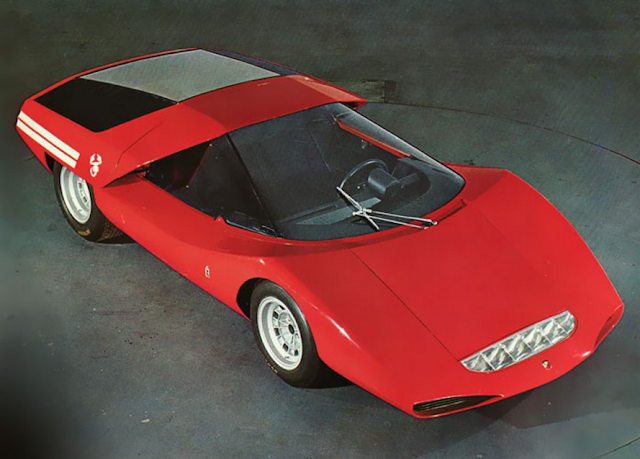Pininfarina moved to the forefront of Italy's (and that meant the world's) independent car design studios during the 1950s. By 1960, Battista "Pinin" Farina's firm had amassed a portfolio of notable designs for show cars as well as production models for Alfa Romeo, Lancia and Ferrari in Italy, Peugeot in France, BMC in Britain, and Nash in America. They had moved into large scale series production of bodies for Alfa Romeo, Fiat and Peugeot. At the beginning of a new decade that would become associated with radical change, Pinin Farina and engineer Alberto Morelli proposed a radical rethinking of automotive form. It was the PFX*, and it proposed a diamond-plan layout for the 4 wheels, simplifying suspension and drivetrain with a single steered wheel at front (no Ackerman effect required to adjust inner and outer turning radii) and a single wheel driven at the rear by a diagonally-mounted 4 cylinder engine (no differential needed either). The goals were to get the noise and heat of the drivetrain behind a spatially-efficient passenger cabin, reduce aerodynamic drag, and increase directional stability with those tall fins. The car was exhibited at 1960's Turin auto show, but did not attract any orders from major manufacturers...
By 1961, Pininfarina had compounded "Pinin" and Farina into a single name, and ditched the diamond-plan wheel layout for the Pininfarina "Y", which appeared at that year's Turin show. The engine was at the rear, but in a more conventional arrangement with a differential driving the two parallel rear wheels. At first, PF kept the stabilizing fins...
...but later shaved them off the car so the body forms presented a more unified, flowing appearance.
Pininfarina, along with other coach building houses like Vignale, offered so many futurist bubble show cars during this period that automotive journalists began to wait for "next year's Turin egg." The PFY survived, and was exhibited during Monterey Car Week nearly three decades later.
As the Swinging Sixties shifted into high gear, Pinin Farina, who died in spring 1966, seemed to realize that the concept cars which might best attract attention from car manufacturers would be ones based upon racing and sports cars. There were some innovative sedans, notably the 1967 BMC 1800 Aerodynamica that influenced the Citroen CX of 1970, but the PF cars that captured the public's imagination, and perhaps design contracts from car makers, were stunners like the 1969 Abarth Scorpione 2000, designed by Filippo Sapino. In it, PF adapted a rear-engine chassis, and echoed the monospace wedge popularized by competitor Giorgetto Giugiaro, with sci-fi motifs blasting car design into the Space Age...
Sapino's design had subtleties that rewarded close examination. It wasn't really a monolithic form, but only appeared that way in plan and elevation. Breaks in the planes surrounding the one-piece lift-up cockpit canopy allowed air flow into the hooded air intakes flanking the cabin. A deft touch was the use of the slanting plane connecting the front fenders to house the pivot for the single windshield wiper. At the rear, PF made an asset of the increasingly outdated rear-mounted engine (mid-engine designs had already taken over racing) by exposing the engine to view, and detailing the trademark Abarth exhaust like a rocket motor.
During his brief time with Pininfarina before becoming famous at Ghia, Sapino also designed the 512S Berlinetta Speciale, the first Ferrari show car to move away from flowing curves to an almost-monolithic wedge, amended by the modeling of the front fenders as well as the deep air intakes which flanked the one-piece canopy with its combined windshield and roof surface.
The view below shows how the roof rises slightly between the air intakes, and how the fenders rise above the hood surface, unlike on the Scorpione from the same year. Despite the name, the car was actually based upon the chassis of a wrecked 612S Can Am car, and the engine block in the original show car had no internals, so the car was towed up a hill for the Pininfarina photos in the wild outdoors. While the Berlinetta Speciale was not a functioning car, it would have sufficed as a prop in a science fiction movie about racers in the 21st Century...
If Ford's GT40 was, at 40 inches from road to roof, the lowest car ever offered to the public, Pininfarina's Ferrari 512S Modulo was one of the lowest cars never offered to the public. Strictly a concept car to wow crowds (and especially auto industry execs) at shows, the 1970 Modulo, penned by Paolo Martin, measured 36.8 inches from road to rooftop. It was wide at 80.3 inches, anticipating (perhaps) later mid-engine production Ferraris like the Testarossa. Despite the mid-mounted 5 liter V-12, wheelbase was a tidy 94.5 inches, only a bit more than the compact 250 SWB from the Sixties, also designed by PF. Access was again permitted (grudgingly) by a one-piece canopy over the true monospace wedge form organized around the red-accented planar break encircling the car. With 550 hp on tap, zero to sixty came up in 3.1 seconds. With nearly floor-to-ceiling side windows, passing 18-wheelers must have been a cinematic experience...
*Footnote: The PFX mechanical layout and body design are depicted in more detail in "Architect-Designed Cars: Part 2", in these posts for 5-21-17. The Abarth Scorpione 2000 concept car was given the essay treatment in "Pininfarina Abarth Scorpione 2000: It Looked Like Rocket Science", from 6-6-16.
Photo Credits:
Top (PFX) & 2nd (PFY): Pininfarina
3rd (PFY): allcarindex.com
4th (PFY): George Havelka
5th thru 7th: Pininfarina
8th: George Havelka
9th: Pininfarina
10th: George Havelka
11th & Bottom: Pininfarina



































































